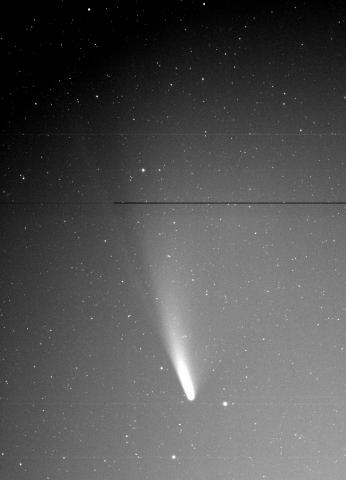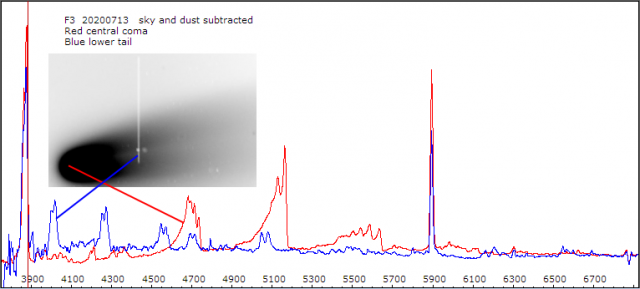- This topic has 152 replies, 42 voices, and was last updated 4 years, 8 months ago by
 Bill Ward.
Bill Ward.
-
AuthorPosts
-
16 July 2020 at 7:51 pm #582845
 Nick JamesParticipant
Nick JamesParticipantVery impressive result Robin.
16 July 2020 at 10:13 pm #582847 David StrangeParticipant
David StrangeParticipantClear here again tonight! Also just realised that my Canon has been imaging at f/27! Wondered why I wasn’t getting the ion tail recorded, hope to do better now!
David
18 July 2020 at 5:15 am #582854 Nick JamesParticipant
Nick JamesParticipantIt certainly looks more prominent and the dust tail close to the nucleus doesn’t have the prominent dark band any more. Here’s my take from this morning. https://britastro.org/node/23324
18 July 2020 at 8:49 am #582855 Mike HarlowSpectator
Mike HarlowSpectatorA quick look at the spectrum from this morning suggests the sodium emission is much weaker now. Colour images of the dust tail certainly look less ‘orange’ which maybe why the ion tail looks much more prominent(?). I initially put all this down to the poor seeing this morning but I think it’s real.
Will post images/spectra on my members site when I’ve had a closer look. Was also imaging Gyulbudaghian’s and Borisov’s VNe last night so a lot of images to plough through!!!
Mike.
18 July 2020 at 9:15 am #582856 Nick JamesParticipant
Nick JamesParticipantI’d noticed the colour change too. That’s very interesting. I should have been flying off to La Palma this weekend but that was cancelled due to C19. That comet would have been a great target from the top of the mountain.
18 July 2020 at 11:46 am #582857 Nick JamesParticipant
Nick JamesParticipantAttached is the blue channel of my widefield image last night (Sony A7s, 50mm f/1.8 lens). The FoV is around 40 x 27 deg and the subs are stacked on the comet’s motion. It was hazy last night and I have horrible gradients to get rid of. Also my flat field hasn’t worked properly. This shows up as concentric rings in the sky background. I need to redo the flat and do some more fiddling to get an image but this shows an ion tail around 25 deg long.
 18 July 2020 at 11:51 am #582858
18 July 2020 at 11:51 am #582858 Hugh AllenParticipant
Hugh AllenParticipant spectrum at 22.00UT on 20200716.png)
I captured an Alpy spectrum of the bright coma and adjacent tail on Thursday evening. I removed the sky background from the spectrum but I didn’t attempt to subtract the solar spectrum from sunlight reflected off the dust in the coma. So the sodium emission will be weakened a little by that, but I think only by a very small amount. Compared to spectra taken a week or two ago, the yellow sodium emission certainly has weakened considerably relative to the blue-green C₂ emission bands, hence the subtle change in colour I think. In my comparison it can be seen how the sodium emission persists out into the tail whilst the molecular emission bands fall away in intensity. Visually the tail was huge, extending far from the bright nucleus especially in averted vision – a beautiful sight!
Hugh
18 July 2020 at 1:52 pm #582859 Martin MobberleyParticipant
Martin MobberleyParticipantClear overhead last night but quite a bit of haze/low cloud in the direction of the comet. Unfortunately the comet is now just above the orange/yellow glow of Bury St Edmunds some 6 miles away, the worst place it could possibly be. A couple of fixed tripod 50mm f/1.4 shots and a blurry tracked shot with a much slower (f/5.9) Tak FS60c were taken.
Martin
18 July 2020 at 2:43 pm #582860 Robin LeadbeaterParticipant
Robin LeadbeaterParticipantA (sky subtracted but uncorrected for instrument response) spectrum image showing a cross section through the coma, taken 20200713.985 with the ALPY600 (An extreme non linear gamma contrast stretch had been applied to reveal the outer regions while not saturating the inner coma) Full size image attached

Although very intense, the sodium emission is confined to a narrow region of the central coma, particularly compared with the CN band which is visible well beyond the dusty region.
Robin
18 July 2020 at 2:57 pm #582861 Robin LeadbeaterParticipant
Robin LeadbeaterParticipantHi Hugh,
Interesting. This cross section through the coma appears to show a different story to this vertical section.
https://britastro.org/comment/8942#comment-8942
Perhaps there could be some directional effects in the differences between Dust,Na D and other emission bands with the gas emission moving off the slit to the left relative to the dust. I have some cross sections across the tail still to analyse which might shed more light.
Cheers
Robin
18 July 2020 at 3:26 pm #582862 Richard MilesParticipant
Richard MilesParticipantImaged July 16 around 22:00UT with a Canon 300mm lens showing detail up to ~3 degrees from the head of the comet. Took some trouble to generate an accurate flatfield before the clouds rolled in and cut short the session. More details on my Members’ Page. Most of England was clouded out that evening.
18 July 2020 at 3:50 pm #582863Neil Morrison
ParticipantClear in Crawley after two nights of Cloud Set up Sky watcher Star adventures with Sony 65a slt and Minolta Rokkor 200mm f4.00 Lens. . It took some time to find the Comet as the electronic view finder struggled. Changed to Samyang 85 mm F 1.4 and the view finder lit up brilliantly. Centred Comet and replaced the 200mm Rokkor. . First results attached lots of work to do to get an acceptable result but B/W frame at 200 mm shows the size of the Tail The second image is a cropped image from the 85 mm lens. Lots of work to do to refine images
18 July 2020 at 5:05 pm #582864 Stewart MooreParticipant
Stewart MooreParticipantA frustrating night (July 17 / 18) for visual observers. Observing from 23:00UT. Comet is buried in low cloud and haze to the north and at times only the nucleus is seen naked eye. It does not improve as the comet rises. In 10x50B the first 2 degrees of the tail is seen and for a few fleeting seconds the tail extends to at least 5 degrees but then it disappears. It seems that these first couple of degrees are much brighter that the remainder. All this is most disappointing as I got the impression that in a clear sky the comet would be looking superb. When visible the tail is very broad with much detail. The tail tonight is a very good example of the benefits of averted vision, often 5 degrees seen with AV and zero with DV.
18 July 2020 at 7:38 pm #582853 Grant PrivettParticipant
Grant PrivettParticipantIs it just me or is the blue ion tail becoming more prominent, or is it merely that the comet is higher in the sky now?
Attached is a stack from the night of 17/8th July. When the comet spent an hour just above a line of clouds on the northern horizon.
18 July 2020 at 10:47 pm #582865 Hugh AllenParticipant
Hugh AllenParticipant stacked spectrum image.png)
Hi Robin
Here is the stacked spectrum after geometric correction with the slit oriented vertically through the centre of the coma and upwards into the tail region. It is possible to see the sodium emission extending upwards into the tail region
Cheers
Hugh
18 July 2020 at 11:43 pm #582866 Robin LeadbeaterParticipant
Robin LeadbeaterParticipantThat’s great. There is definitely no Na extending out that far sideways in my image so combining the two images we see just Na near the centre of the coma and streaming out in the tail direction.
Cheers
Robin
19 July 2020 at 3:31 pm #582868 Bill WardParticipant
Bill WardParticipantHi all,
Even though it is getting a little darker I’m still struggling with bright twilight when it comes to imaging at my lattitude. This is (an un-corrected in any way!) crop from a shot taken with a FLI KAF39000 camera and a 165 f2.8 lens, 3 x 30 secs through a HMC Y1 Green filter.

The filter helped take out some of the “blue sky” background. The broadening fan of the dust tail is becoming apparent.
Maybe get to try again in another couple of weeks!
19 July 2020 at 4:46 pm #582870 Robin LeadbeaterParticipant
Robin LeadbeaterParticipantA spectrum of the emission lines from the comet tail.

It is very different to those of the coma usually seen in amateur spectra and is dominated by CO+ emission lines (the absolute intensity in the spectrum is only ~1% of that in the coma spectrum)
Cheers
Robin
19 July 2020 at 8:26 pm #582871 Hugh AllenParticipant
Hugh AllenParticipant tail spectrum at 22.00UT on 20200716.png)
Hi Robin,
How do you approach the dust subtraction? It’s a very nice tail spectrum. It inspired me to re-check my rather noisy tail spectrum just beyond the brightest part of the coma. I realise that I could pick out the three most intense double-peaked CO+ bands in the spectrum
Cheers
Hugh
19 July 2020 at 8:43 pm #582869 David SwanParticipant
David SwanParticipantA fascinating object. Friends and passers-by have been out for a look and have been most impressed. I have found that non-regular stargazers, with just help to point them in the right direction, are able to pick it up with the naked eye and notice the fuzziness reaching upwards. Most people favour the view through binoculars (10 x 50s) rather than the telescope (200mm SCT, 32mm Plossl). I am pleased to have been able to pick up the ion tail with just single frames with a DSLR! A greenish tint is also appearing in the coma, as highlighted by Nick James in a recent email.
-
AuthorPosts
- You must be logged in to reply to this topic.
